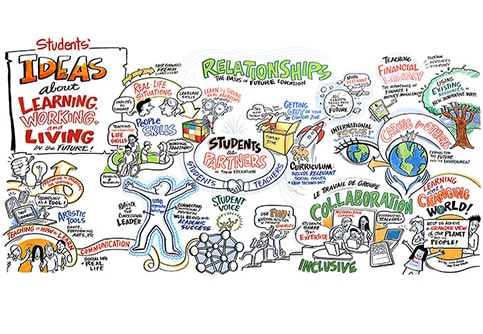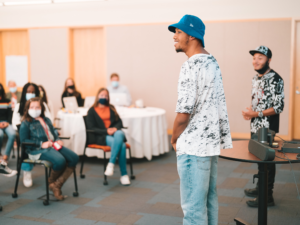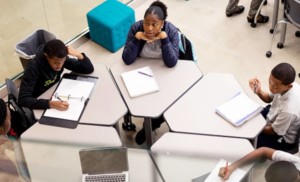What if Students Made a School?

This blog first appeared on blendmylearning.com.
Tom Carroll
What would happen if we trusted students to design their schools? Student voice and choice are core principles of a personalized learning movement that is empowering today’s youth to take responsibility for the knowledge, skills and abilities they need to thrive in college, careers and life.
As new education models grow to support this movement, are we ready to take the next step: asking students to help us customize the staff, space, curriculum, tools, and time they need for deeper learning?
To answer this question, the International Society for Technology in Education (ISTE) sponsored a series of student design competitions in the late 90s based on Jack Foster’s thought-provoking book If I Could Make a School (Center For Strategic Policy Studies, 1991). Teams of high school students were challenged to create a vision of schools that could meet their needs as 21st century learners.
Although these competitions took place over a decade ago, the students developed five design concepts that are as relevant today as when they were originally drafted.
1. Co-Created Curriculum
The students wanted to play an active role in personalizing their own learning.
They envisioned schools that would embrace them as contributing stakeholders in a learning community that would support their individual learning pathways, with activities that were co-created with them, not for them. In the words of one student: “Imagine being able to grow, learn, and explore your own curiosities whenever and however you want…Imagine the feeling of unrestricted discovery. Imagine being free.” Big Picture Schools, which was in its infancy when these design competitions took place, is perfecting this concept today.
2. Collaborative Learning
In addition to being active learners, the students were social learners.
When their abilities were stretched, they wanted to reach out to friends, teachers, and outside experts who could give them real-time problem-solving feedback that would accelerate their mastery of new knowledge and skills. They wanted schools in which they could not only learn more, but learn how to do more and create more with what they know. Buck Institute, New Tech Network, and High Tech High now have over a decade of experience implementing this concept.
3. Commitments from Capable Adults
The students wanted small learning communities in which each individual could to turn to a capable adult for support.
Perhaps more than any other school attribute, students valued teachers who would take the time to know them well, who would care about their needs and aspirations, and who would be committed to their personal success. Students from low-income communities were frustrated by high teacher turnover in their schools: “When our teachers leave we feel abandoned – if they don’t care about us, why should we care about school?” This concept is at the heart of every high performing school that is bucking the odds for high risk students. (For more on this concept, see Building and Sustaining Talent: Creating Conditions in High-Poverty Schools That Support Effective Teaching and Learning.)
4. Connected Learning – Doing Real Work
The students envisioned schools without boundaries.
They understood that computers and the Internet could link them to a learning culture that is larger in scale and richer in resources than any school we have ever known. They wanted schools that would develop their ability to navigate this new learning environment. They were eager to explore their passions and discover their purpose by working shoulder-to-shoulder with accomplished adults on real-world problems. “Don’t give us computers to do schoolwork – give us computers to do real work.” Today this looks like HIVE Learning Networks, which are fostering connected learning communities across the country. Social Creatives is using networked connectivity to create opportunities for youth to engage in meaningful learning, doing work that makes a difference.
5. Comfortable, Customizable Learning Space
The students wanted to deinstitutionalize their schools.
They wanted soft, comfortable furniture that could be quickly and easily rearranged to support the demands of their work as it evolved. They wanted colorful walls and active spaces that allowed for lots of movement during learning activities that flowed easily from indoors to outdoors and back. The students also wanted quiet nooks, safe “nests,” and attractive hang-out spaces in which they could read, study, share stories, and engage in quiet uninterrupted reflection on their experiences. “We sit all day in uncomfortable chairs in a classrooms with pukey walls – how can anyone learn in that? … When you enter our school you should want to stay there to learn with us.” The American Architectural Foundation’s Design for Learning initiative is assembling a team of leading-edge school design professionals to transform factory-era schools into 21st century learning environments.
Taken together, these five design concepts are about the difference between schools that students are required to attend and schools that they own.
Personalized learning works when students see that their ideas are heard and their contributions are valued.
Youth thrive when they know that their teachers, school leaders, parents and community members are working with them to create schools that embrace learning principles they value.
The good news is that these design concepts are being incorporated into a growing array of next generation learning environments. Each year, an expanding number of education leaders are creating new design forums that help today’s youth and advocate for their vision of 21st century schools. The Business Innovation Factory is sponsoring a team of high school students who are designing a school that will open in Providence RI next fall. In a similar fashion, the Independent Project, which started at Monument Mountain High School in Massachusetts is charting a path for students who are becoming learning design thinkers.
So ask yourself: What would happen if you trusted your students to help you create the schools of the future?
For more on LX, check out:

Tom Carroll is President Emeritus of the National Commission on Teaching and America’s Future and a Design For Learning Senior Fellow at the American Architectural Foundation.




Ed Jones
Tom, after years of research and three years of development, this is exactly what we offer. Not just to students of a few schools; but to student of all schools. Co-created curriculum. Deeper learning. Real work. Expanded physical environments. Connected learning. More committed, learned adults.
All of it.
Things are still ugly and crude. We've built up a substantial network on the ground. We've identified even more potential partners. The fundamentals are sound. This is a solid and huge path forward.
True transformation, however, requires funding. All of the past three years and more has been completed without a single dime of edu-stablishment, foundation, or angel money. It's innovative. It doesn't fit in their boxes. It looks like change and it scares them.
Systemic change is here: http://badgeHS.com.
IF someone with power or funds will embrace it.
Replies
Tom Vander Ark
Thanks Ed
Carmen Watts Clayton
This is the most common-sense design principles for educational settings that will work that I have seen! Way to go Tom! These are my feelings exactly and I support giving students more power to create their classroom environments and curriculum structures. I am doing this in my special needs class and the results are outstanding. Now how do we get administrators and other school leaders to see the wisdom of this plan and implement it?
Replies
Tom Vander Ark
ThanksCarmen, we agree this is a great summary of student-centered learning
Billie Jordan
I did this about three months ago with my high school ESL students and one of my children is from China and he said many of their school had sleep pods, where you could go for thirty minutes anytime in the day and just rest or chill out and absorb what you had learned for that day. Sometimes I think our children know more of what is really needed than we do. High school is a very stressful time in a child's life and I thought this was a great decision and it lead us to research and find out some statistics on sleep pods!
Bjordan
HJ Wright
This is a very interesting article If you care about the impact of design and environment on a child's ability to learn.
https://arcsedge.com
Having read this I believed it was rather enlightening.
I appreciate you finding the time and energy to put this information together.
I once again find myself personally spending a lot of time
both reading and posting comments. But so what, it was still worthwhile!
Police Clearance Certificate UAE
Excellent way of telling, Thanks for sharing